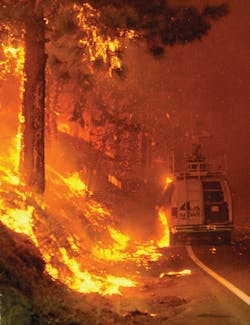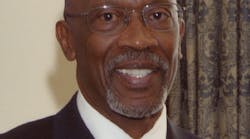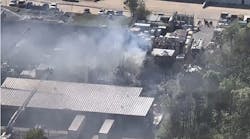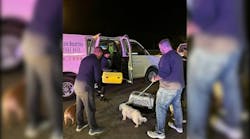The number of ways news is gathered and reported has increased vastly since the heyday of big-city newspapers and major broadcast TV networks. What has not changed is the media’s willingness to go where the story is. This is not always safe; in fact, reporters have been injured and killed doing their job.
But is their job to get the news protected by the U.S. Constitution? Apparently, the general rule consistently applied by the courts in interpreting the First Amendment is that the media have the same right of access as the public; no more and no less. In the 1972 case Branzburg v. Hayes, the U.S. Supreme Court said, “It has been generally held that the First Amendment does not guarantee the press a constitutional right of special access to information not available to the public generally.” The court further stated, “Newsmen have no constitutional right of access to the scenes of crime or disaster when the general public is excluded…”
California is one of only a few states with media-access laws. Two other states with codified access laws are Ohio and Virginia. These laws let the media venture beyond where the public is allowed to go at crime and disaster scenes, although they cannot interfere with responders or disturb potential evidence. In most other states, the media can be prevented from going places and doing things beyond what responders prevent the public from accessing. One main reason for denying access is safety.
The first responsibility of responders is to protect life. Historically, members of the media have chosen to give up that protection to cover a story. Therein lies the conundrum for responders. “Life safety first” is what the responders’ oath usually includes, but what do they do when people – i.e., the media – are willing to place themselves in harm’s way to get a story? Who is responsible for the media when they are in harm’s way? Is it responders? If reporters are given access and are be injured, killed or need rescue, can responders be held liable for allowing the access in the first place? For states like California, Ohio and Virginia the solution was seemingly straightforward: Give the media access to crime and disaster scenes, but make certain they do so at their own risk, thereby removing safety as a mitigating factor for preventing access.
California has a large amount of wildlands and forests. Along with that comes fire, which is part of the natural environment. To cover fires that can at times grow into raging conflagrations, the media believe they need to go “beyond the tape” to record such drama as firefighters in action, property destruction and the aerial efforts of firefighting aircraft. It is natural for people who swear an oath to protect life and property to be concerned about the safety of the media.
Firefighters train regularly to safely fight wildland fires. The concern was how to provide safety training for the media, particularly in California, where the media sometimes arrive at the fire the same time as firefighters. For many years, fire departments would have media fire safety days at their headquarters or training facilities. I remember as a member of the media in the late 1980s attending such an event at the then-CDF (California Department of Forestry and Fire Protection) Academy in Ione. Media members participated in firefighting situations, with live fire, guided by the academy training staff.
When I became the CAL FIRE San Bernardino Unit information officer, I helped set up such safety events. It was a good way to get a story about CAL FIRE and fire safety on the air or in the newspapers, but it didn’t provide fire safety training for more than the reporters and camera persons who attended the events.
In 2002, then-Fire Prevention Battalion Chief Doug Lannon and I decided to develop training to provide fire safety education for all members of the media; i.e., reporters, photographers, editors, producers and managers. We brought the training directly to media outlets, dramatically increasing the number of people trained. We also felt this program would help develop a closer relationship between the media and CAL FIRE, increasing the media’s understanding of what CAL FIRE and the fire service as a whole do.
With no template or example to follow, we created a specialized four-hour program. We wanted it to be more than a “be careful around fires and wear your safety gear” class. We wanted to share knowledge about fire behavior and how fires are fought. The program was designed to accomplish several objectives:
1. To provide an overall look at fires and safety while encouraging the media to enhance their safety.
2. Through an increased understanding of wildland fire behavior and operations, the media would improve their reporting and photography.
3. To help the media provide higher-quality reporting, which would better educate the public.
The program we developed used PowerPoint, video and handouts. Topics included a legal review (primarily the state’s media-access law), personal protection equipment, parts of a vegetation fire, wildland fire behavior, fireground injuries and fire shelters. Over the years, we improved the program to meet the needs of the media while reflecting changes in tactics, operations and safety issues facing the fire service.
Following a successful rollout in Los Angeles, we made the class deliverable by anyone. Over the years, it has been made available as a turnkey operation to other CAL FIRE units. We provide the PowerPoint presentation, copies of our videos and masters of the handouts. Other CAL FIRE units localize the class for their media. Daniel Berlant, the CAL FIRE information officer at headquarters in Sacramento, takes a version of the class statewide for media that request it.
Some news organizations have videotaped the presentations for in-house training. In 2009, the NBC network in New York used a taped version to create a 90-minute intranet class for East Coast staff and stringers who might have occasion to cover major wildland fires. Last year, another edition was provided for NBC channel 4 in Los Angeles. It is indeed an honor that our material is being used in this way.
The class is still available through an email to me at [email protected].
Bill Peters
Unit Information Officer
Fire Prevention Specialist
California Department of Forestry and Fire Protection
San Bernardino, CA
The writer has been public information officer for CAL FIRE since 1991, with 10 years of experience on Type I Incident Command Teams as a lead information officer. Previously, he was a TV and radio reporter, anchor and news director and a Los Angeles County sheriff’s deputy.
Aging Firefighters
Re: “Younger Volunteers Wanted,” For The Record, January 2012: It is paradoxical and perplexing to read of the NFPA’s legitimate concerns regarding both a declining and aging force of volunteer firefighters, while many politicians are advocating the reduction of retirement benefits for professionals, including working into their 60s. Obviously, the issue of aging firefighters is of legitimate concern for both volunteer and professional departments. And, if the current political climate toward professional firefighters continues, professional departments may eventually experience recruiting problems as well.
Many professionals, myself included, began their involvement with the fire service as volunteers, and have a better understanding and appreciation of volunteer departments than might be perceived. The problem of recruiting should have been anticipated by the late 1990s or 2000, after the publication of Robert Putnam’s book Bowling Alone and the academic paper from which it evolved. Putnam cited the declining numbers of members involved in fraternal and civic groups and youth and adult sports leagues (hence, “Bowling Alone”), referring to it as “America’s Declining Social Capital.
“Social networking” takes on a different, even an electronic meaning today, than it did in an era of more abundant and younger volunteers. Many younger people congregate in “niche” groups of common interests, and it appears that volunteer firefighting is no longer one such interest.
All of us who have served as volunteers know well the importance of community and personal relationships, often not really so different from those which evolve in a paid municipal department. America’s increasingly transient, mobile workforce does not always lend itself to involvement in volunteer fire departments. The corporate climate too is likely to be less understanding of the volunteer who suffers a long-term, disabling injury or even to let that employee leave work to respond, as many of us were able to do.
Quite frankly, even over 40 years ago, I never found our county and others any more willing to support even the minimal equipment, logistical and training needs of our volunteers than they would later be of their professionals. Nor were they any more appreciative of their services. And now, we should have little expectation that such local governments are going to be very creative in recruiting and rewarding volunteers. After all, many politicians are doing everything possible to make a career as a professional firefighter less attractive and less rewarding than it has been for decades.
I have often found it interesting too how many of these small communities where even many professionals accept the community’s inability to support at least a partially paid or combination department can nearly always afford paid, professional law enforcement. It should also be remembered that firefighters in every service profile almost always provide emergency medical first response as well.
Many of these communities may find themselves having little choice but to pay in one way or another for what is most certainly a core function of government – the protection of citizens in an adequate and effective manner.
Larry Osborne
12th District Vice President
International Association of Fire Fighters
Jacksonville, FL
Remembering
Hal Bruno
I read with sadness of the passing of Hal Bruno. There are many heroes of fire department lore, and I would say Hal is right in there at the top. He was one of the true honorable people who have graced the confines of the fire service community. May we find another such as Hal to keep the fire service’s integrity alive. Keep up the wonderful work in the articles written for all firefighters to read, enjoy and learn.
John Adams
Battalion Chief (ret.)
Los Angeles City Fire Department
Los Angeles, CA







